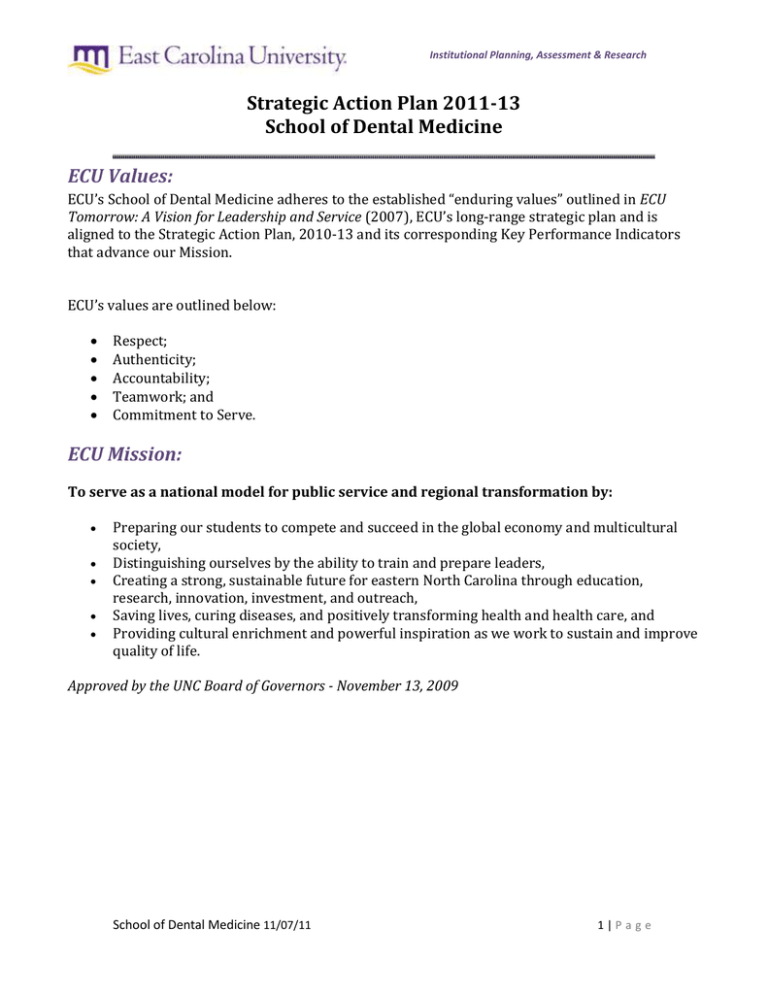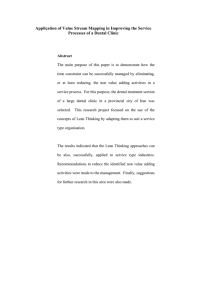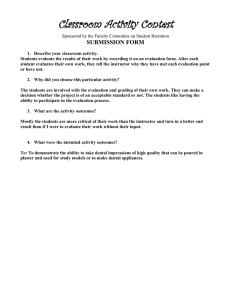School of Dental Medicine
advertisement

Institutional Planning, Assessment & Research Strategic Action Plan 2011-13 School of Dental Medicine ECU Values: ECU’s School of Dental Medicine adheres to the established “enduring values” outlined in ECU Tomorrow: A Vision for Leadership and Service (2007), ECU’s long-range strategic plan and is aligned to the Strategic Action Plan, 2010-13 and its corresponding Key Performance Indicators that advance our Mission. ECU’s values are outlined below: Respect; Authenticity; Accountability; Teamwork; and Commitment to Serve. ECU Mission: To serve as a national model for public service and regional transformation by: Preparing our students to compete and succeed in the global economy and multicultural society, Distinguishing ourselves by the ability to train and prepare leaders, Creating a strong, sustainable future for eastern North Carolina through education, research, innovation, investment, and outreach, Saving lives, curing diseases, and positively transforming health and health care, and Providing cultural enrichment and powerful inspiration as we work to sustain and improve quality of life. Approved by the UNC Board of Governors - November 13, 2009 School of Dental Medicine 11/07/11 1|P a g e Institutional Planning, Assessment & Research Key Strategic Planning Principles: Several key planning principles were established to develop this strategic plan: Support for student success throughout the continuum of their college learning experience; Adherence to ECU Tomorrow: A Vision for Leadership and Service, 2007 and the ECU Strategic Action Plan, 2010-13; Support for effective leadership and professional development; Purposeful decision-making, moving towards clearly defined goals and measurable objectives; A commitment to institutional effectiveness; and, Allocation of resources to ensure attainment of established priorities. Goals: GOAL 1: GOAL 2: GOAL 3: GOAL 4: GOAL 5: Provide a high quality educational experience that prepares students to deliver outstanding dental services to underserved and rural communities in North Carolina in a caring and compassionate manner. Attract and retain students who are representative of our state’s minority and rural populations. Ensure excellence and sustainability in meeting the oral health care needs of the underserved communities and populations we serve. Create a dynamic and rewarding work and educational environment. Become national leaders in dental health services research, epidemiology, public health and clinical trials. School of Dental Medicine 11/07/11 2|P a g e Institutional Planning, Assessment & Research Goal 1: Provide a high quality educational experience that prepares students to deliver outstanding dental services to underserved and rural communities in North Carolina in a caring and compassionate manner. Outcome Objective: By 2013, increase the number of dentists who (are prepared to) practice in rural and underserved areas of the State. Measure: Curriculum measures – developed by curriculum and outcomes assessment committees Measure: Student interview findings are used to evaluate student satisfaction in the scope and quality of their education Measure: First time pass rate on National Board Dental Examination (NBDE), Part I, compared to the national first time pass rate 2012 Measure: First time pass rate on National Board Dental Examination (NBDE), Part II, compared to the national first time pass rate 2014 Measure: Alumni interview findings are used to determine number of graduates, who pursue careers in primary oral health care in rural and underserved areas in North Carolina 2016 Outcome Objective: By 2013, increase the number of opportunities available to dental students to participate in community-based interprofessional co-curricular and extracurricular experiences. Measure: Student group interviews to evaluate student satisfaction in the scope and quality of their experiences Outcome Objective: By 2013, increase the number of professional development opportunities available to dental students. Measure: Student group interviews to evaluate student satisfaction in the scope and quality of their education GOAL 2: Attract and retain students who are representative of our state’s minority and rural populations. Outcome Objective: By 2013, increase the number of underrepresented students admitted. Measure: Enrollment rates by gender, ethnicity, program and county Outcome Objective: By 2013, maintain the retention rate of underrepresented students at or above 95 percentage points. Measure: Retention rates by gender, ethnicity, and program, and county. Measure: Trends in student: staff ratios Measure: Number of students having documented academic difficulty Measure: Number of students utilizing tutors and mentors School of Dental Medicine 11/07/11 3|P a g e Institutional Planning, Assessment & Research Outcome Objective: By 2013, increase the amount of financial support available to students through financial aid, scholarships, grants, and loans. Measure: Amount of financial support available to SoDM students Outcome Objective: Increase the number of mentee relationships established. Measure: Number of mentee relationships Measure: Students feedback surveys/focus groups GOAL 3: Ensure excellence and sustainability in meeting the oral health care needs of the underserved communities and populations we serve. Outcome Objective: By 2013, increase the number of Community Service Learning Centers (CSLCs) that deliver high quality oral health services in underserved and rural areas of our state by ten. Measure: Number of CSLCs established Outcome Objective: By 2013, increase the number of patients receiving oral health services in underserved and rural areas of the state. Measure: Number of patients served by CSLC Outcome Objective: By 2013, increase opportunities for students to provide oral health care services in CSLSc. Measure: Number of affiliation agreements Measure: Number of 4th year students with rotations in rural/underserved regions of the State Outcome Objective: By 2013, increase opportunities for students to provide oral health care services in CSLS. Measure: Number of programs serving children and underserved adults Measure: Number of children and underserved residents receiving care Measure: Documentation of established partnerships that address oral health Outcome Objective: By 2013, increase the number of grant applications secured to meet the oral health care needs of underrepresented populations. Measure: Number of grants submitted and awarded by dollar value Measure: Rate of return of investment strategies Outcome Objective: By 2013, increase the amount of funding secured for oral health care delivery via awareness of and support for funding through advocacy with legislators. Measure: Amount of resources secured Measure: Rate of return of investment strategies School of Dental Medicine 11/07/11 4|P a g e Institutional Planning, Assessment & Research GOAL 4: Create a dynamic and rewarding work and educational environment. Outcome Objective: By 2013, increase the number of faculty and staff from historically underrepresented groups, including women. Measure: Annual demographic profile (number, percent) of faculty and staff Outcome Objective: By 2013, increase faculty and staff satisfaction with their ability to attain their written professional development goals. Measure: Climate survey Measure: Annual performance review feedback Measure: Number and ratio of faculty tenured and/or promoted Outcome Objective: By 2013, establish policies and procedures that optimize achievement of the SODM’s mission. Measure: Climate survey Measure: Annual performance review feedback GOAL 5: Become national leaders in dental health services research, epidemiology, public health and clinical trials. Outcome Objective: By 2013, increase the number of interdisciplinary and inter-institutional projects focused on oral health.Measure: Number of partnerships secured Measure: Assessment of Research agenda Measure: Ongoing assessment of faculty development opportunities Outcome Objective: By 2013, increase the number of interprofessional collaboration research projects that focus on oral health care. Measure: Number of interprofessional collaborations Measure: Number of partnerships that advance multidisciplinary activities Outcome Objective: By 2013, increase the number of interprofessional collaboration research projects that focus on oral health care. Measure: Percentage of School’s new graduates who enter private practice Measure: Percentage of new graduates who enter graduate and specialty programs in hospitals and universities throughout NC Measure: Percentage of new graduates who pursue options including military or public health service, dental research, dental education and careers with a variety of NC government agencies Outcome Objective: By 2013, increase access to (the number of) continuing education opportunities related to the translation of oral health research into patient care. Measure: Number of continuing education opportunities School of Dental Medicine 11/07/11 5|P a g e




